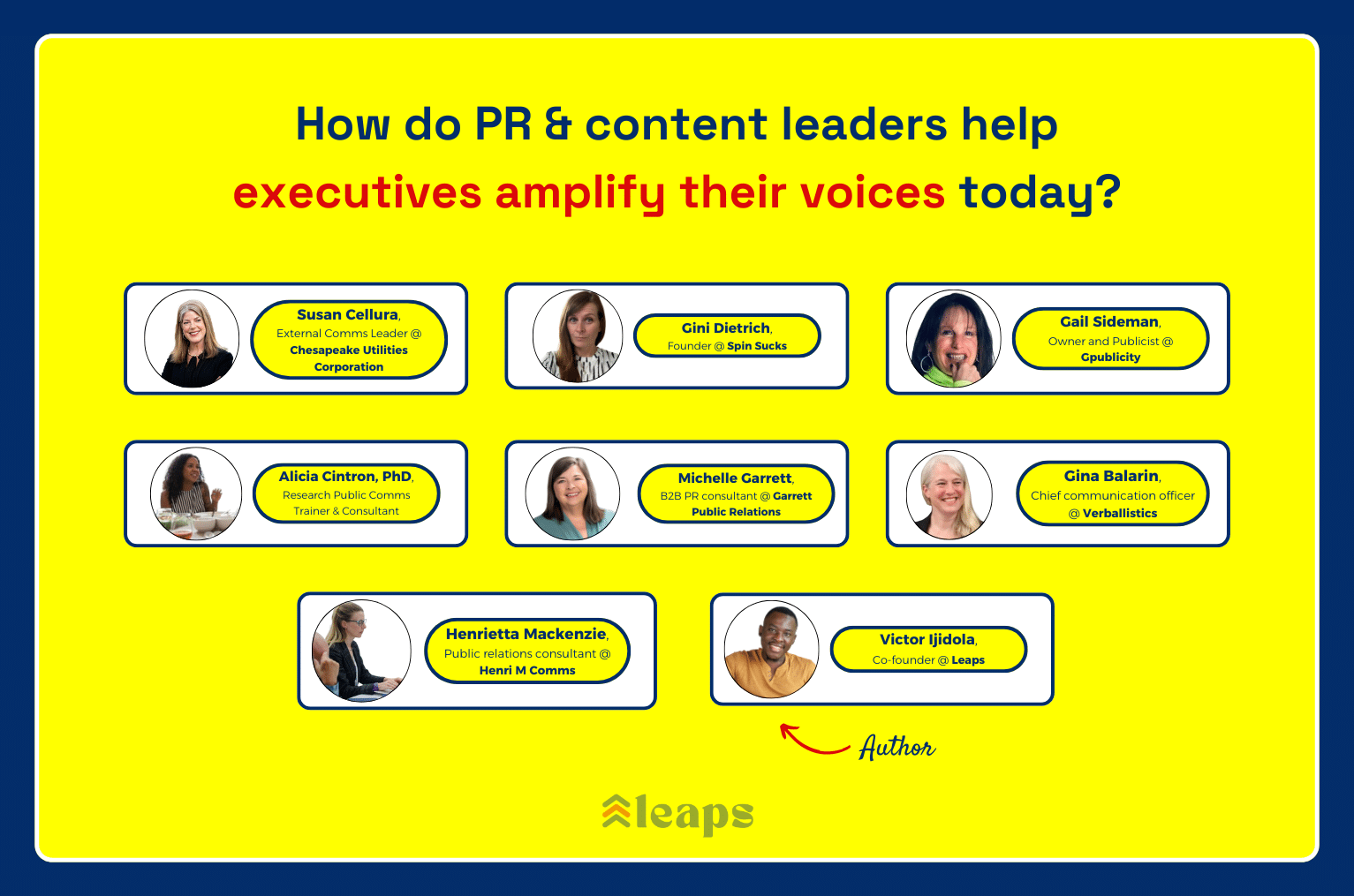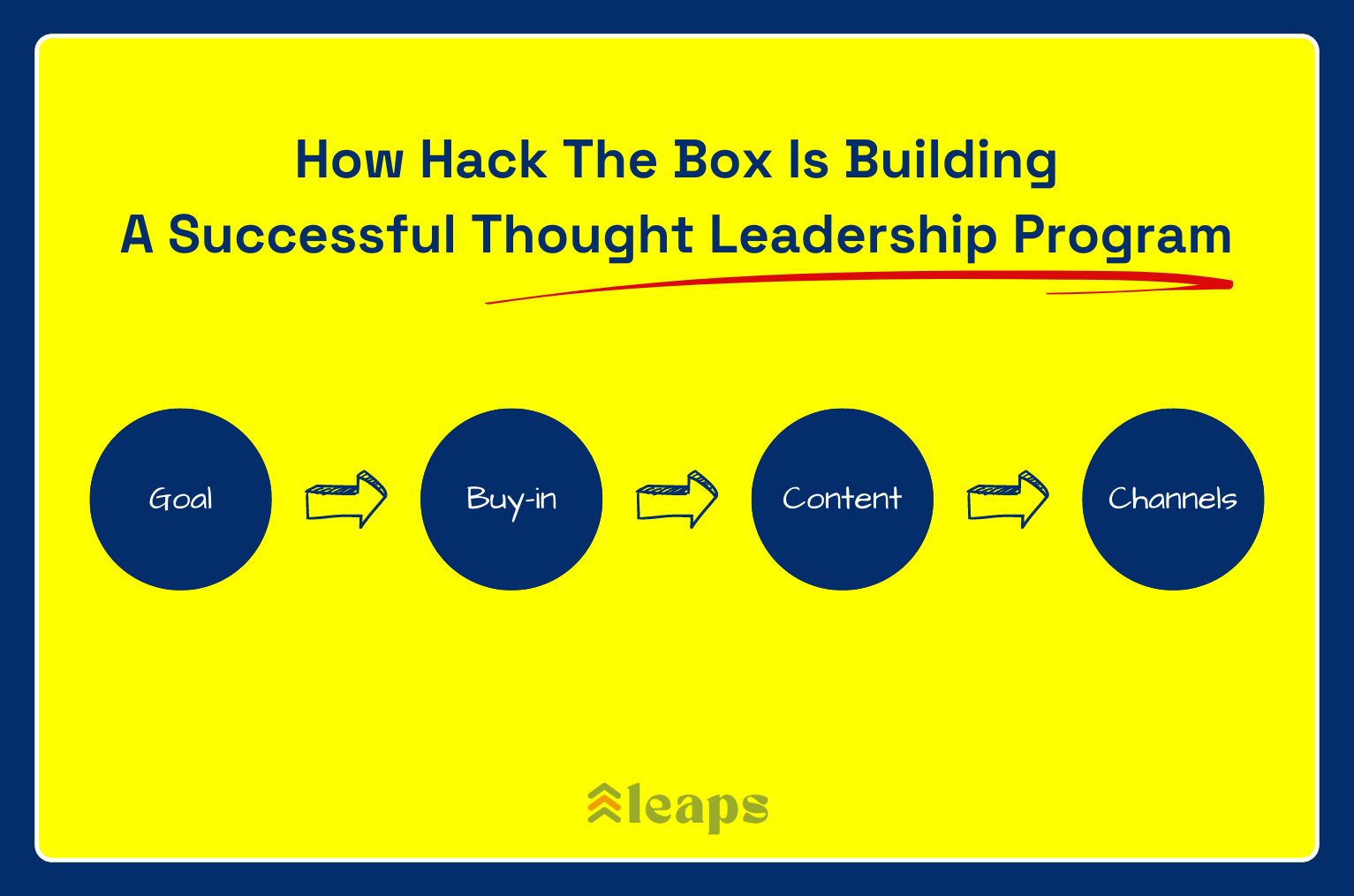About a month ago…
I asked my LinkedIn connections a question about thought leadership:

Basically, “What does thought leadership mean to you?”
And I got several responses. But one thing was clear in all:
Thought leadership is when a subject matter expert (SME) shares insights from their industry experience about topics they’re experts on.
And when they do that, they connect deeply with target audiences, improve sales for the brands they represent, and so on.
But all of that won’t happen without first developing a thought leadership strategy.
What’s inside:
Basics first; what’s a thought leadership strategy?
Thought leadership strategy is the plan you create to share the thoughts, findings, and opinions of your brand with a specific audience and for a specific goal.
That goal could be to drive awareness for a brand or product, drive conversations with a particular target audience, reduce the length of sales cycles, and so on.
Whatever the goal, your thought leadership strategy is how you intend to get there.
How to create an effective thought leadership strategy
Massive thank you to all the amazing content leaders who agreed to share their experiences on this topic:
Sylvie Combastel (Global Head of Marketing & Communications @ Shell), Aimee Savran (Senior Content Marketing Manager @ Orca Security), Katy Schroedl (Content Marketing Manager at ProShip, Inc.), Caitlin R. Weiner (Content Manager @ HackerOne), Jessy Iype (Senior Manager- Content @ FCI CCM), JP Myler (Brand and Creative Content Manager @ NAPA), Susi O’Neill (Head of Brand Content (global) @ Kaspersky), Matt DiVenere (Director of Content Development @ Optimum Healthcare IT), and Paul Bauer (Head of Content at Cezanne HR).
Here’s how they all do thought leadership strategy:
1. Lay your foundation
Laying out your foundation here means spelling out the things I mentioned earlier:
Your audience, thought leadership goal(s), pain-point topics, and distribution channels.
The head of global thought leadership at Shell shared her thoughts with me on how important this is in her process:

Sylvie Combastel
Global Head of Marketing & Communications @ Shell
Speaking about the steps she typically takes to build a thought leadership strategy, Sylvie shared she starts with:
- “A clear understanding of my audiences and their “pain points”
- Creating a framework built from my brand needs and ambitions (aka building a strategy that helps to hit business goals and outcomes)
- Deciding and agreeing on what the key channels/media and formats will be
- Building the plan, and creating and sharing the content
- Checking performance from the very beginning and adapting.”
“I’ve been using this process with my content partner agency and we get very interesting results (over 130% marketing ROI) and some industry awards for the content programs we’ve been releasing.”
2. Look at external and internal signals for topics
If there’s one thing that stops audiences from scrolling on any feed, it’s relevance.
If your topics are relevant to them, they’ll pay attention.
So picking the right topics is critical to building any thought leadership strategy.
The global head of brand content at Kaspersky shared a few tips with me that they use to find topics to fuel content:

Susi O’Neill
Head of Brand Content (global) @ Kaspersky
“Internal: what are the pain points and ‘hot trends’ that those in field marketing are hearing about from their customers that they want to create more talking points for?
“Then also external trends data: looking at search trends, and what big consultancies are talking about on any given topic.
“From this, it’s a Venn diagram approach:
– where do these trends connect with our expertise?
– what are things we want to become famous or better known for?
“That then gives us the topic.
“The content strategy plan follows next where you decide:
– options for distribution and budget
– what formats the content can take, and how it will connect to the core message of the campaign.”
3. Prioritize sharing your “leading thoughts”
There’s the easy vs. hard way to do thought leadership.
Easy way: research what other experts think about your topics, paraphrase their thoughts/opinions, and publish that as “thought leadership.”
Hard way: find what leaders in your company think about your topics and share their original thoughts, letting your audience into the minds of the people leading your company.
Wise marketers know option B works better long term.
This has been the experience of Orca Security’s senior content marketing manager:

Aimee Savran
Senior Content Marketing Manager @ Orca Security
“This consists of starting from a highly-searched question from Google/search engines and then creating content that looks like every other article or post out there.
“Ultimately, this takes the “thought” out of “thought leadership,” since the ideas only come together based on content that’s already published and publicly available.
“If the goal with thought leadership is to contribute your thoughts, it’s important to approach it based on your personal experience.”
The Senior Manager of Content at FCI CCM shared a similar perspective when I asked if there was something they’d noticed that was wrong with the way content leaders build their thought leadership strategy:

Jessy Iype
Senior Manager- Content @ FCI CCM
“To know [and share] the thoughts of leaders, they should put their thoughts into it.”
And when I asked Aimee about the steps to take to build a thought leadership strategy, her process starts with clearly defining and identifying who a thought leader is in your organization:
“Building a thought leadership strategy begins with identifying real thought leaders in your company/team.
“Define for yourself what a “thought leader” really means, being as specific as possible about what knowledge that person should have.
“From there, work with the thought leader(s) to identify important topics to share with the world through published content (whether it’s blogs, social media posts, videos, etc.), being especially mindful to let the thought leader(s) guide on which topics are most important to address.
“If the thought leader(s) isn’t well-versed in content marketing, prompt the content by asking them to explain the top industry problems they notice and what should be done to address those — that’s the best way to get the ball rolling.
“From an ongoing strategic standpoint, it’s important to educate the thought leader(s) on the value of consistency and work with them to stay alert on industry trends and opinions so they can share their perspective through published content.
“Lastly, work with the thought leader(s) to identify key industry influencers so they can engage online with their content, both to challenge and agree with points made by those influencers.
“This promotes continued dialogue and debate, two essential components of gaining credibility in a given industry.
“My process comes from a place of authenticity rather than a fabricated, exaggerated foundation.
Aimee concluded by sharing what this looks like in her role as a senior content marketing manager:
“Some real-life experience for me relates to working in the cybersecurity industry, where I’m working with industry veterans who have decades of experience.
“While I’m in a senior manager-level content marketing role, my expertise lies more in content marketing, not cybersecurity, and it would be very apparent to our target prospects/customers the value I can provide them versus an industry veteran.
“When I’ve approached thought leadership strategy through this lens, we’ve been able to build up a loyal community of followers, listeners, subscribers, etc. because it’s evident the person/people our audience is listening to actually know what they’re talking about.”
4. Spotlight your differentiation
Our third point above was all about prioritizing your leading thoughts.
And that shouldn’t change.
But beyond that, you, more importantly, need to put a BIG spotlight on what makes your brand different in your industry.
The Content Manager at Vena Solutions puts this more succinctly:

Nicole Bennett
Content Manager @ Vena
“What new behavior or way of thinking are you trying to incite in your audience?
“This should ultimately come from your product positioning.
“To build our current thought leadership strategy, we started with our core product differentiators (why do our customers choose us over competitors) and then distilled this into a few core messages we want to build awareness of.
“Importantly, we then established what the intended outcomes of getting these messages into the market would be (since they should ultimately roll up to business objectives).
“Now we have a clear plan to work off of when planning out our content topics for the year.”
And speaking about how they collaborate with or interview subject matter experts to create thought leadership content, Nicole shared how they do it:
“With so much commodity content out there (and growing — thanks AI), having expert-sourced insights is now table-stakes if you want high-quality, differentiated content.
“We aim to source subject matter experts for every piece of content we create. Working with partner marketing to source experts is great since partners are likely to participate as they’ll want the opportunity for co-marketing.
“A lot of the partners we work with have small marketing teams and therefore can’t create much content in-house, so they appreciate the boost.
“You can also make use of any expert content that’s already been generated through other channels like your podcast if you have one, webinars, events, customer meetups, and internal town halls. These can be a huge time saver.”
5. Answer questions that haven’t been answered
More often than not, building a thought leadership strategy requires asking your SMEs a series of questions so you can incorporate their ideas into your content.
But you’ll need to ask them the right questions.
And one way to do that is to know which questions aren’t getting answered in already published content.
HackerOne’s content manager mirrored a similar idea when I asked her to share the steps she typically takes to build a thought leadership strategy, here’s what she shared:

Caitlin R. Weiner
Content Manager @ HackerOne
“Conduct thorough research on the topics to understand what content is already out there, what’s resonating, and what gaps and questions still exist that you can answer with your content.
“Use this research to craft questions for your subject matter experts and to help optimize your content for search and other media.
“Only then will you have the clearest picture of your thought leadership and the forms it should be able to take: long-form blog post, social media, podcast, byline, etc.”
6. Plan what distribution should look like
Content distribution often feels difficult for thought leadership content.
Especially if you don’t have an owned audience or any organic search traffic in sight (as is the case for many, if not most, thought leadership pieces.)
But promoting thought leadership isn’t impossible.
There are always influencers you can partner/co-market with, industry newsletters to sponsor, or even just audience-targeted ads.
When I asked the content marketing manager at ProShip to share her steps for building a thought leadership strategy, she said:

Katy Schroedl
Content Marketing Manager at ProShip, Inc.
“Within those, take a closer look at:
– who you are trying to influence,
– what content formats matter to them,
– how you build relationships with them after sharing the content, and then
– how you measure success.”
When speaking about collaborating with SMEs for creation and distribution, she advised making it super clear to them that it’s a win-win:
“I would say it’s probably a tie between tailoring your approach and highlighting the mutual benefit — you have to make them understand that you value their expertise and that they are getting something out of the collaboration.”
Typically, this could mean showing SMEs examples of how it’s been a win-win for SMEs in the past, including the number of impressions, shares, or other metrics they’d care about.
7. Put connecting with your audience above selling
As marketers, we want our work to drive revenue.
Not only because we want to do impactful work but also to prove value to leadership.
So it’s often a constant struggle to balance thought leadership and selling.
But in reality, if you’re sharing thought leadership pieces around the right topics, they’ll end up selling your products/services.
I like how NAPA Auto’s brand and creative content manager put it:

JP Myler
Brand and Creative Content Manager @ NAPA
“Let’s face it, we consume content all day every day and when you think about the content that you resonate with the most, it’s content that is relatable or solves an issue that you’ve experienced.
“First you must start with your brand (not the company the brand built) and the purpose of the brand.
“Why does it exist and what does it do for people? Take that and build a strategy around whatever channel you’re developing content for.
“I’m used to developing content pillars for each channel and each content pillar ladders up to the overall strategy for the channel, the department, and the business.
“There should always be a clear answer to “why” for every piece of content you develop.”
And when I asked JP to share any real-life experience to reinforce why you should follow her process, she said:
“I’ve witnessed success on every channel I’ve been lucky enough to work on but it definitely takes a team.
“I’ve personally read the comments, I’ve seen the data, and have seen vast improvements in engagement and value.
“You can learn so much about your brand and what it means to people through the comments, I’m not above getting in the weeds there.
“Other content leaders do not have to follow my exact process but it would be smart to at least understand the brand, the channel, and the audience thoroughly before going into content development.
“I believe authenticity has everything to do with what I’ve seen drive success in real-life experiences.
“Whatever channel you’re creating a content strategy for, it must feel authentic to the brand and what people use the channel for. If it’s not, users see through that. They move on and they do it quickly.”
8. Keep open communication lines with SMEs
Things change a lot in every industry and SMEs are at at forefront of those changes.
As a content leader, you need to stay ahead of those changes.
And of one the best ways to do that is to keep talking to SMEs in your industry and organization, asking them about trends and changes in the industry.
I like how the director of content development at Optimum Healthcare IT keeps open communication lines with SMEs:

Matt DiVenere
Director of Content Development @ Optimum Healthcare IT
“If something is shifting in your world, marketing should be bringing it to the team’s attention. It’s called social listening, and it’s more important than ever in today’s marketing landscape.
“2) Map out your typical client journey and make sure that you have content developed for each step.
“To add thought leadership to the client journey, you need to find a natural place where your brand and your SMEs can connect through content on a topic.
“3) Track your wins and losses. Not all of your thought leadership is going to get the response you want from your audience.
“But don’t get worried! Just keep swimming. Make sure to mention your successes and failures to the SMEs as well.
“You’re all working together toward a common goal. There’s no reason to hide!
“I think what makes marketing unique is that there are so many ways to experiment and find what’s right for you.
“For me, this approach helps foster a stronger marketing presence within the organization which has helped me develop impactful marketing content.
“And in today’s climate where ROI is king, being able to draw a direct line between engaging thought leadership content and down-funnel sales opportunities is crucial.
“Collaboration is the name of the game with thought leadership. If you want your brand to stand out, you’re going to need to identify some SMEs in your organization that you can rely on to develop this content together.”
9. Use search engines *only* as a distribution channel
We’ve heard it several times:
SEO is only a distribution tactic.
Of course, it’ll help you drive traffic to content.
But right after that traffic comes the need for engagement and conversions.
And that’s where thought leadership comes in.
It’s what helps you show authority and authenticity and drive every other business outcome you’re looking for from content.
I love how the Head of Content at Cezanne HR explains how he uses SEO to support their content and thought leadership strategy:

Paul Bauer
Head of Content @ Cezanne HR
“We may be past the bad old days of content keyword stuffing, but it’s a practice that still exists – just in a watered-down form of offering very ‘top level’ content pieces that don’t offer anything of true value.
“Content of course has a huge part to play in how a website performs in organic search rankings; but any good content strategy must put the customer’s needs, wants, and challenges at its center.
“If you deliver content which informs, educates, surprises, and delights its reader, you have a much better chance of building more meaningful engagement, better quality lead gen, and ultimately, brand authenticity.”
And speaking about the steps he typically takes to choose topics relevant to their audience, Paul shared he always starts with pinpointing buyer personas and identifying their core interests:
“I always start with looking at our buyer personas, and what their core challenges, aims, and ambitions are.
“I’ll also look at what our competitors are doing and what topics are ‘hot’ in the press or industries we operate in.
“When I have a ‘hook’ that can potentially solve a challenge or support a target reader, I’ll then look at coming up with content ideas that will resonate with our audiences, or perhaps provide information or ideas which no one else has covered yet.
“I’ll also look to understand how the content fits in the buyer’s journey for our customer and how it can be linked to content we’ve already published, and how it can also be linked to the products and services we offer.”
Strategies may vary, but two things are critical
Your thought leadership strategy could look something like what we’ve covered so far in this guide. Or it could look something different entirely.
That’s okay, but two things are of utmost importance:
- Content/opinions/ideas/POVs in your content should always come from thought leaders or your company’s senior leaders
- Distribution is the only way to make sure your target audience(s) find your thought leadership content and consume it. So you want to create a concrete plan for it.
Hi, I’m Victor Ijidola, co-founder @ Leaps, an easy way to get insights from your SMEs — no calls needed — and turn them into detailed, expert-led content briefs and outlines. If we're not connected yet, I'd love to meet you! 🙂



